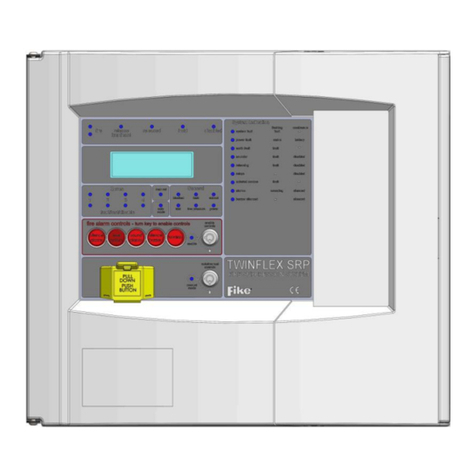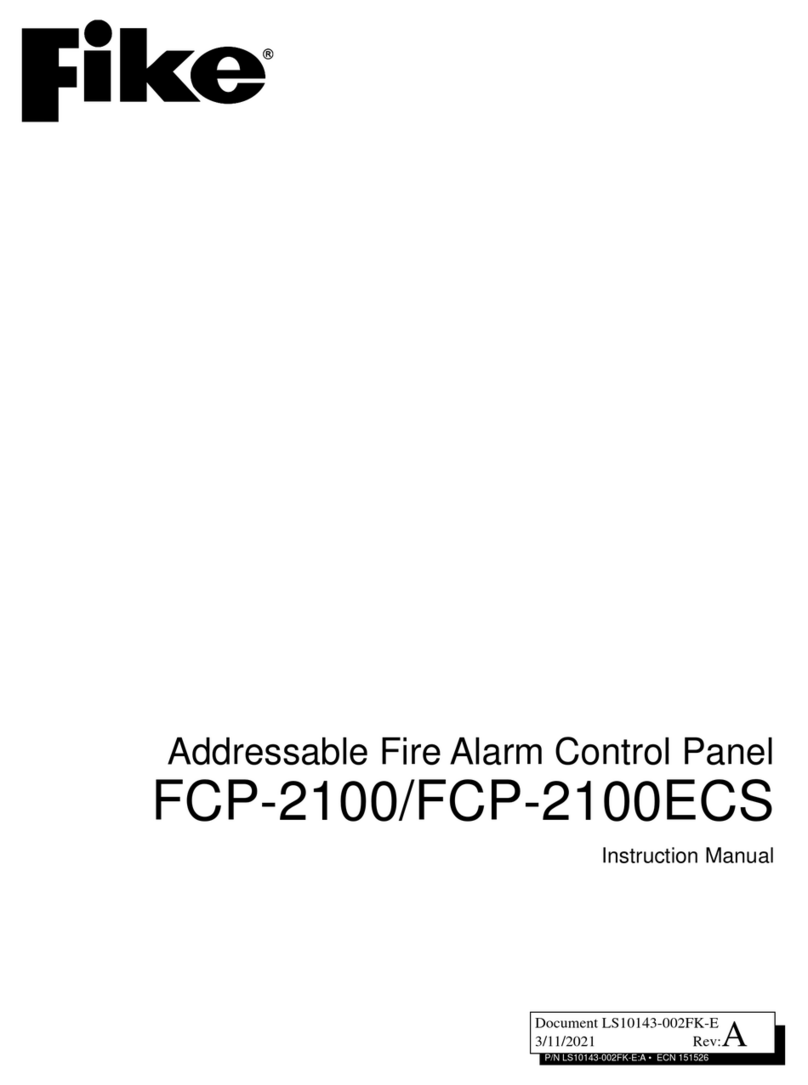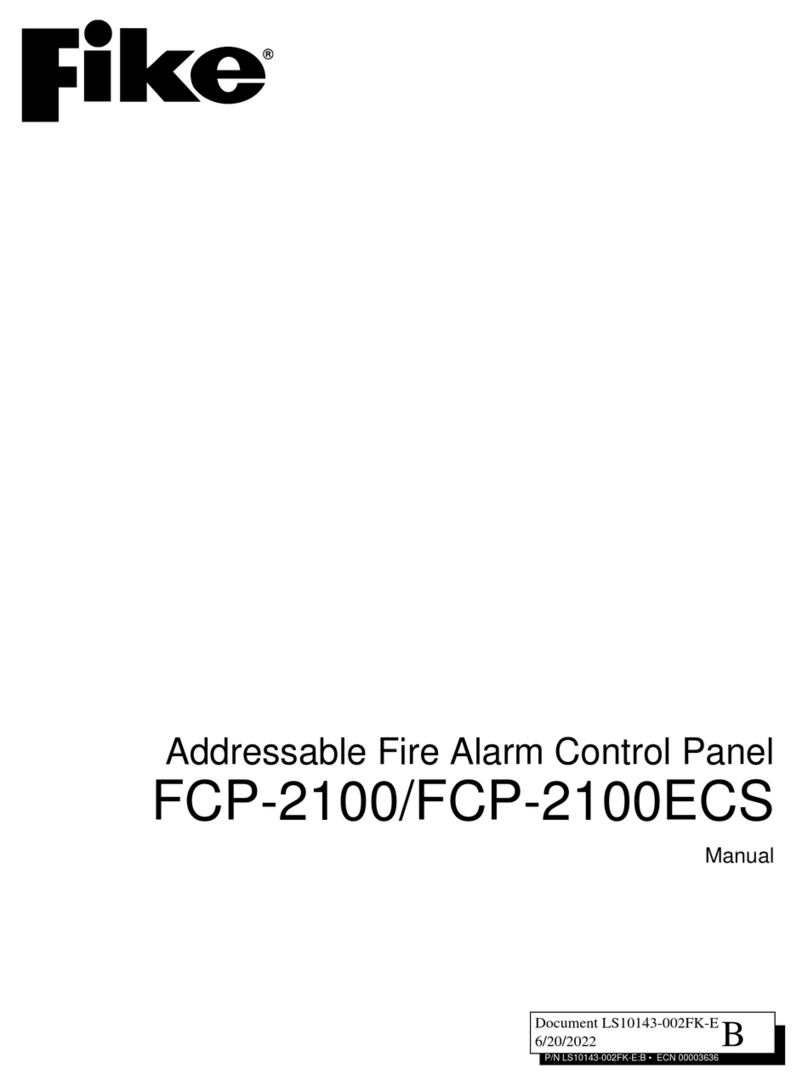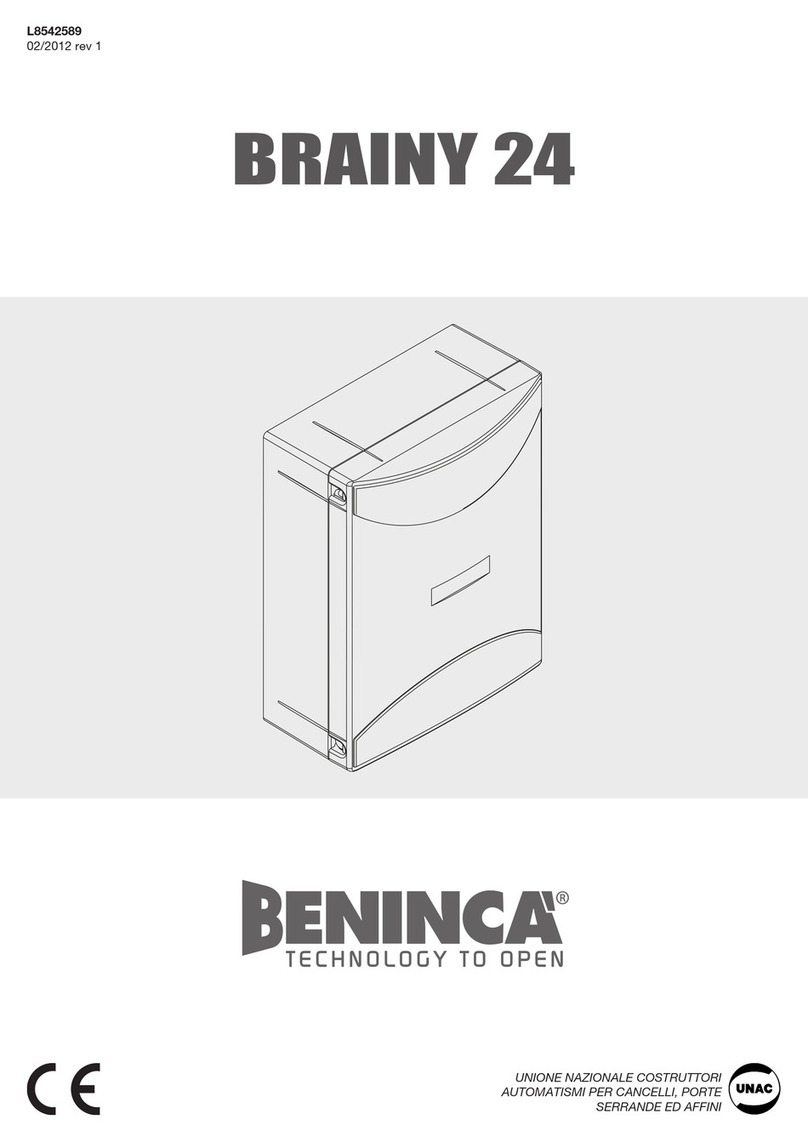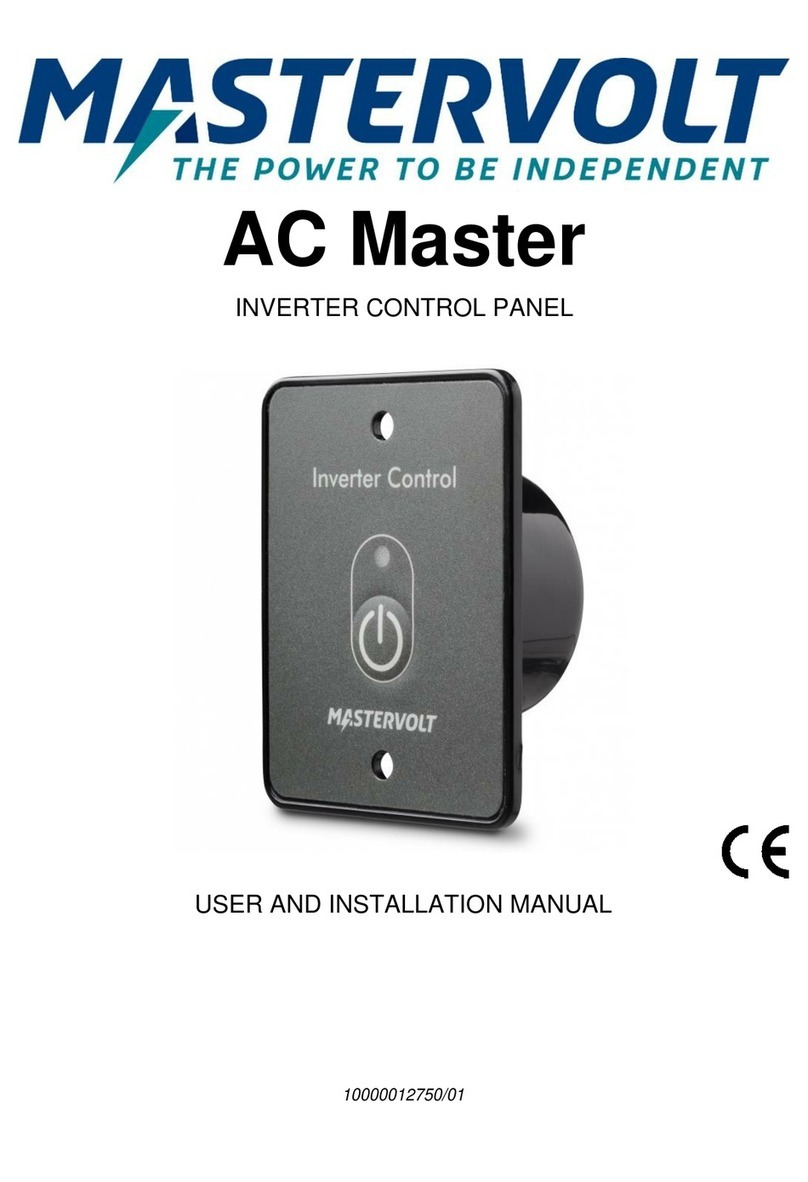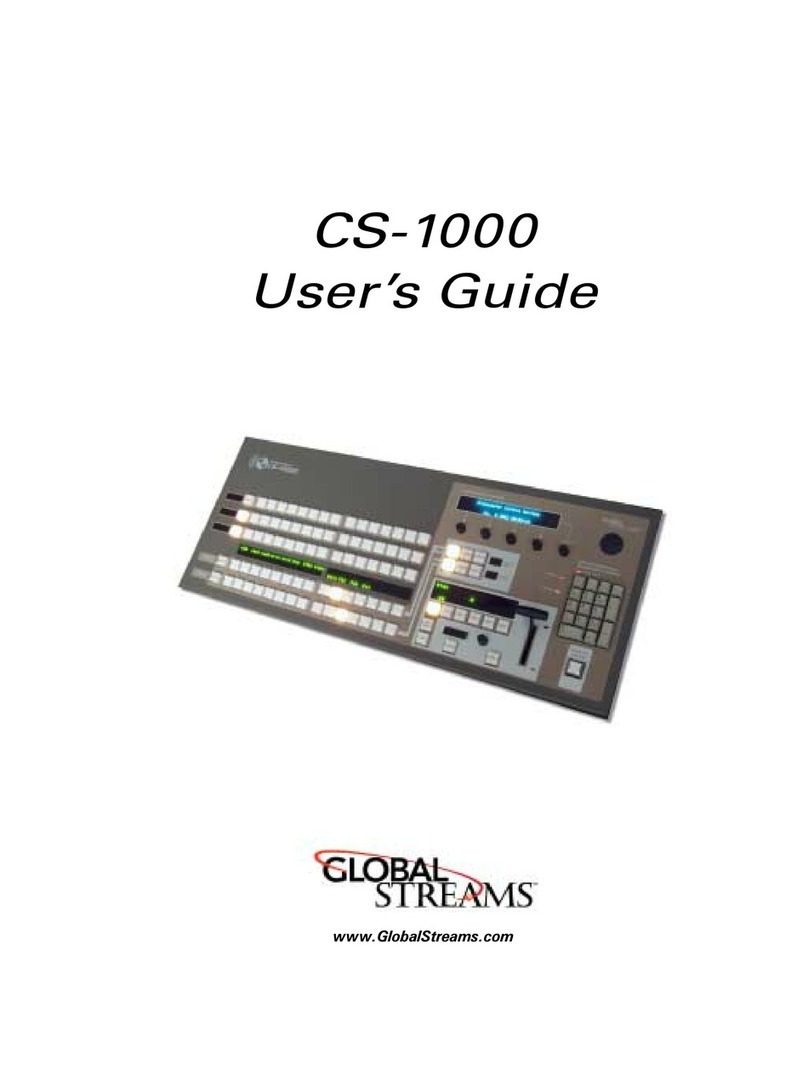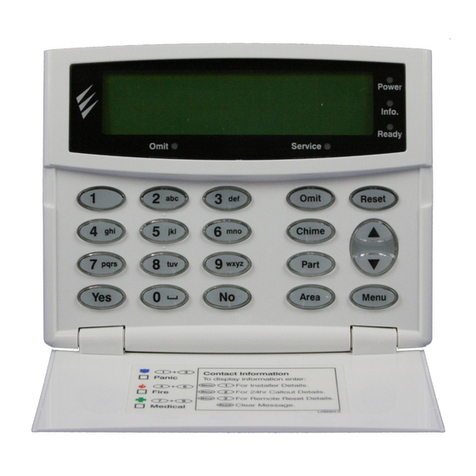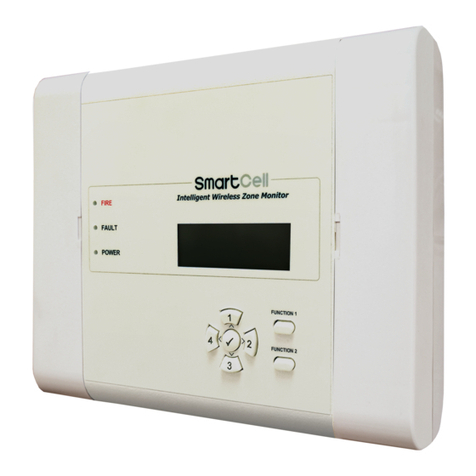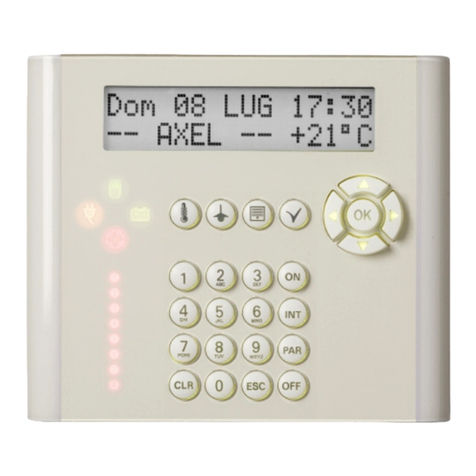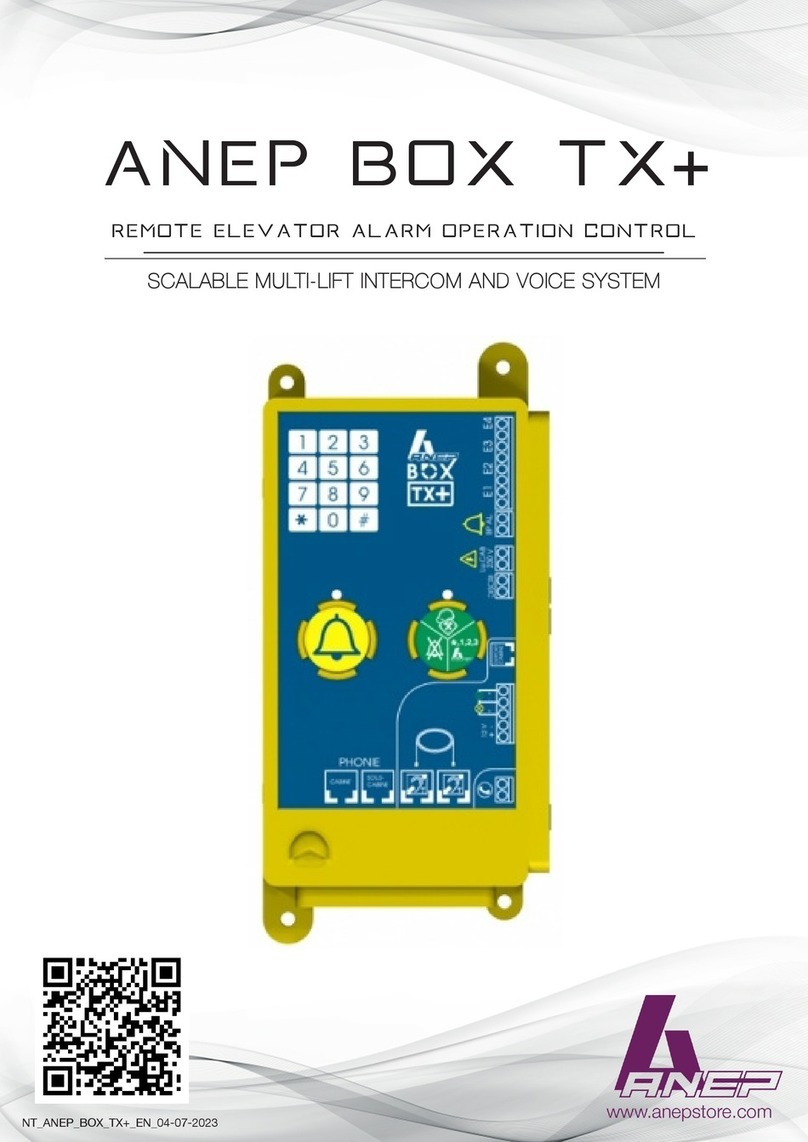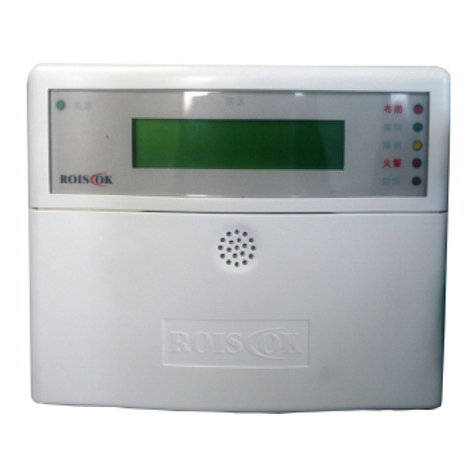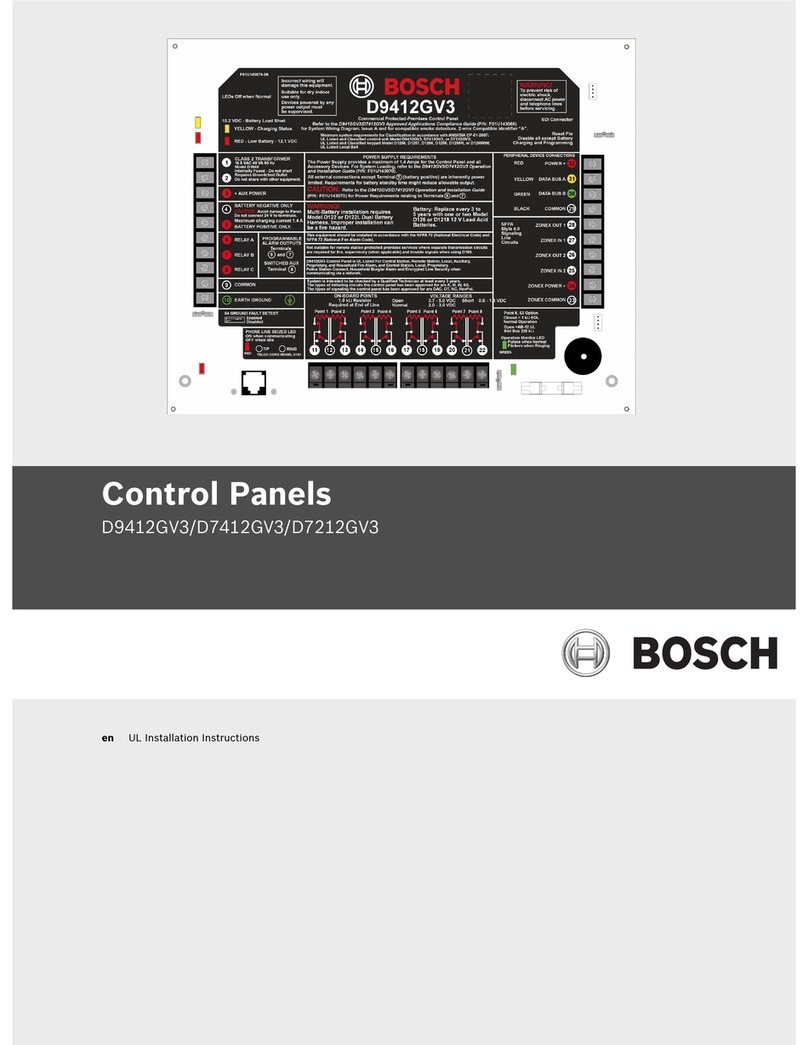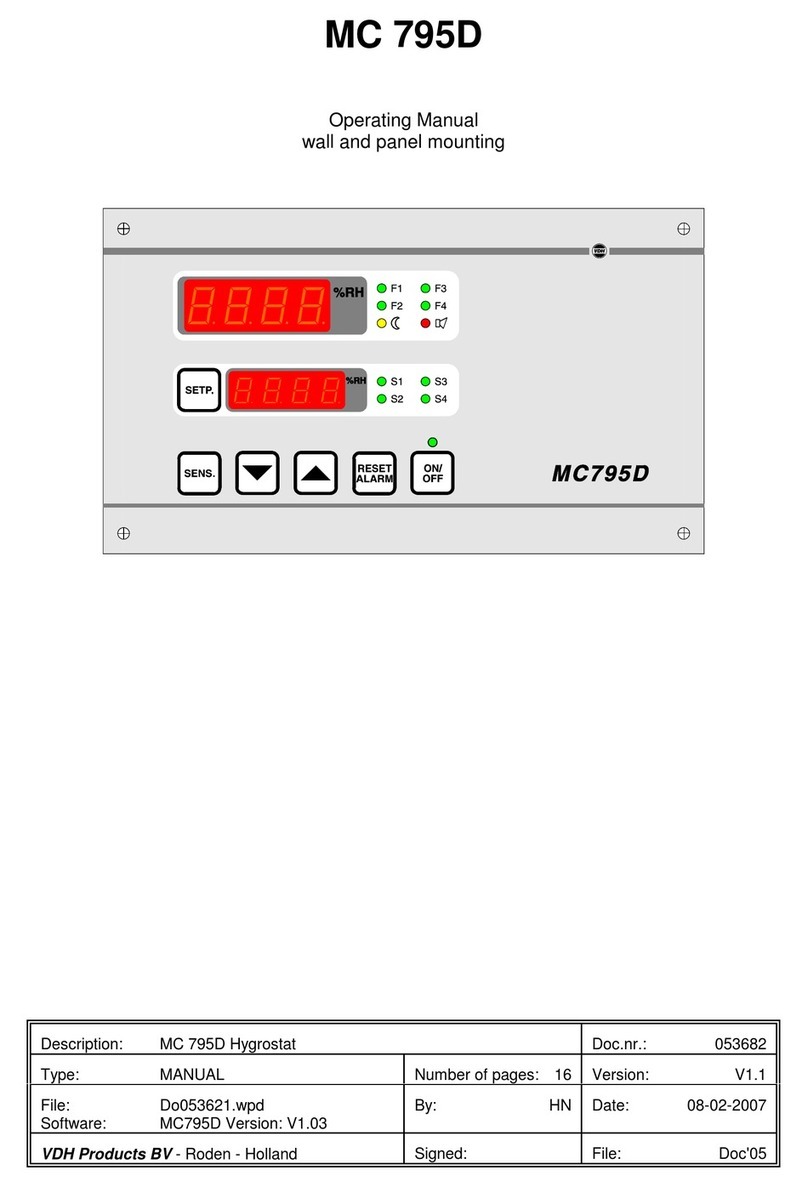Fike FIK-5496 User manual

A
P/N LS10253-001FK-E:A • ECN 151526
Document LS10253-001FK-E
03/02/2021
Distributed Power Module
FIK-5496
Installation/Operation Manual

2FIK-5496 Manual — P/N LS10253-001FK-E:A 03/02/2021
Fire Alarm & Emergency Communication System Limitations
While a life safety system may lower insurance rates, it is not a substitute for life and property insurance!
An automatic fire alarm system—typically made up of smoke
detectors, heat detectors, manual pull stations, audible warning
devices, and a fire alarm control panel (FACP) with remote
notification capability—can provide early warning of a developing fire.
Such a system, however, does not assure protection against property
damage or loss of life resulting from a fire.
An emergency communication system—typically made up of an
automatic fire alarm system (as described above) and a life safety
communication system that may include an autonomous control unit
(ACU), local operating console (LOC), voice communication, and
other various interoperable communication methods—can broadcast
a mass notification message. Such a system, however, does not
assure protection against property damage or loss of life resulting
from a fire or life safety event.
The Manufacturer recommends that smoke and/or heat detectors be
located throughout a protected premises following the
recommendations of the current edition of the National Fire Protection
Association Standard 72 (NFPA72), manufacturer's
recommendations, State and local codes, and the recommendations
contained in the Guide for Proper Use of System Smoke Detectors,
which is made available at no charge to all installing dealers. This
document can be found at http://www.systemsensor.com/appguides/.
A study by the Federal Emergency ManagementAgency (an agency
of the United States government) indicated thatsmoke detectors may
not go off in as many as 35% of all fires. While fire alarm systems are
designed to provide early warning against fire, they do not guarantee
warning or protection against fire. A fire alarm system may not
provide timely or adequate warning, or simply may not function, for a
variety of reasons:
Smoke detectors may not sense fire where smoke cannot reach the
detectors such as in chimneys, in or behind walls, on roofs, or on the
other side of closed doors.Smoke detectors also may not sense a fire
on another level or floor of a building. A second-floor detector, for
example, may not sense a first-floor or basement fire.
Particles of combustion or “smoke” from a developing fire may not
reach the sensing chambers of smoke detectors because:
• Barriers such as closed or partially closed doors, walls, chimneys,
even wet or humid areas may inhibit particle or smoke flow.
• Smoke particles may become “cold,” stratify, and not reach the
ceiling or upper walls where detectors are located.
• Smoke particles may be blown away from detectors by air outlets,
such as air conditioning vents.
• Smoke particles may be drawn into air returns before reaching the
detector.
The amount of “smoke” present may be insufficient to alarm smoke
detectors. Smoke detectors are designed to alarm at various levels of
smoke density. If such density levels are not created by a developing
fire at the location of detectors, the detectors will not go into alarm.
Smoke detectors, even when working properly, have sensing
limitations. Detectors that have photoelectronic sensing chambers
tend to detect smoldering fires better than flaming fires, which have
little visible smoke. Detectors that have ionizing-type sensing
chambers tend to detect fast-flaming fires better than smoldering
fires. Because fires develop in different ways and are often
unpredictable in their growth, neither type of detector is necessarily
best and a given type of detector may not provide adequate warning
of a fire.
Smoke detectors cannot be expected to provide adequate warning of
fires caused by arson, children playing with matches (especially in
bedrooms), smoking in bed, and violent explosions (caused by
escaping gas, improper storage of flammable materials, etc.).
Heat detectors do not sense particles of combustion and alarm only
when heat on their sensors increases at a predetermined rate or
reaches a predetermined level. Rate-of-rise heat detectors may be
subject to reduced sensitivity over time. For this reason, the rate-of-
rise feature of each detector should be tested at least once per year
by a qualified fire protection specialist. Heat detectors are designed to
protect property, not life.
IMPORTANT! Smoke detectors must be installed in the same room
as the control panel and in rooms used by the system for the
connection of alarm transmission wiring, communications, signaling,
and/or power. If detectors are not so located, a developing fire may
damage the alarm system, compromising its ability to report a fire.
Audible warning devices such as bells, horns, strobes, speakers
and displays may not alert people if these devices are located on the
other side of closed or partly open doors or are located on another
floor of a building. Any warning device may fail to alert people with a
disability or those who have recently consumed drugs, alcohol, or
medication. Please note that:
• An emergency communication system may take priority over a fire
alarm system in the event of a life safety emergency.
• Voice messaging systems must be designed to meet intelligibility
requirements as defined by NFPA, local codes, andAuthorities
Having Jurisdiction (AHJ).
• Language and instructional requirements must be clearly dissemi-
nated on any local displays.
• Strobes can, under certain circumstances, cause seizures in peo-
ple with conditions such as epilepsy.
• Studies have shown that certain people, even when they hear a
fire alarm signal, do not respond to or comprehend the meaning of
the signal.Audible devices, such as horns and bells, can have dif-
ferent tonal patterns and frequencies. It is the property owner's
responsibility to conduct fire drills and other training exercises to
make people aware of fire alarm signals and instruct them on the
proper reaction to alarm signals.
• In rare instances, the sounding of a warning device can cause
temporary or permanent hearing loss.
A life safety system will not operate without any electrical power. If
AC power fails, the system will operate from standby batteriesonly for
a specified time and only if the batteries have been properly
maintained and replaced regularly.
Equipment used in the system may not be technically compatible
with the control panel. It is essential to use only equipment listed for
service with your control panel.
Alarm Signaling Communications:
•IP connections rely on available bandwidth, which could be lim-
ited if the network is shared by multiple users or if ISP policies
impose restrictions on the amount of data transmitted. Service
packages must be carefully chosen to ensure that alarm signals
will always have available bandwidth. Outages by the ISP for
maintenance and upgrades may also inhibit alarm signals. For
added protection, a backup cellular connection is recommended.
•Cellular connections rely on a strong signal. Signal strength can
be adversely affected by the network coverage of the cellular car-
rier, objects and structural barriers at the installation location. Uti-
lize a cellular carrier that has reliable network coverage where the
alarm system is installed. For added protection, utilize an external
antenna to boost the signal.
•Telephone lines needed to transmit alarm signals from a premise
to a central monitoring station may be out of service or temporarily
disabled. For added protection against telephone line failure,
backup alarm signaling connections are recommended.
The most common cause of life safety system malfunction is
inadequate maintenance. To keep the entire life safety system in
excellent working order, ongoing maintenance is required per the
manufacturer's recommendations, and UL and NFPA standards. At a
minimum, the requirements of NFPA 72 shall be followed.
Environments with large amounts of dust, dirt, or high air velocity
require more frequent maintenance. A maintenance agreement
should be arranged through the local manufacturer's representative.
Maintenance should be scheduled as required by National and/or
local fire codes and should be performed by authorized professional
life safety system installers only. Adequate written records of all
inspections should be kept. Limit-F-2020

FIK-5496 Manual — P/N LS10253-001FK-E:A 03/02/2021 3
Installation Precautions
Adherence to the following will aid in problem-free installation with long-term reliability:
WARNING - Several different sources of power can be con-
nected to the fire alarm control panel. Disconnect all sources of
power before servicing. Control unit and associated equipment may
be damaged by removing and/or inserting cards, modules, or inter-
connecting cables while the unit is energized. Do not attempt to
install, service, or operate this unit until manuals are read and under-
stood.
CAUTION - System Re-acceptance Test after Software Changes:
To ensure proper system operation, this product must be tested in
accordance with NFPA 72 after any programming operation or
change in site-specific software. Re-acceptance testing is required
after any change, addition or deletion of system components, or after
any modification, repair or adjustment to system hardware or wiring.
All components, circuits, system operations, or software functions
known to be affected by a change must be 100% tested. In addition,
to ensure that other operations are not inadvertently affected, at
least 10% of initiating devices that are not directly affected by the
change, up to a maximum of 50 devices, must also be tested and
proper system operation verified.
This system meets NFPA requirements for operation at 0-49º C/32-
120º F and at a relative humidity 93% ± 2% RH (non-condensing) at
32°C ± 2°C (90°F ± 3°F). However, the useful life of the system's
standby batteries and the electronic components may be adversely
affected by extreme temperature ranges and humidity. Therefore, it
is recommended that this system and its peripherals be installed in
an environment with a normal room temperature of 15-27º C/60-80º
F.
Verify that wire sizes are adequate for all initiating and indicating
device loops. Most devices cannot tolerate more than a 10% I.R.
drop from the specified device voltage.
Like all solid state electronic devices, this system may operate
erratically or can be damaged when subjected to lightning induced
transients.Although no system is completely immune from lightning
transients and interference, proper grounding will reduce susceptibil-
ity. Overhead or outside aerial wiring is not recommended, due to an
increased susceptibility to nearby lightning strikes. Consult with the
Technical Services Department if any problems are anticipated or
encountered.
Disconnect AC power and batteries prior to removing or inserting
circuit boards. Failure to do so can damage circuits.
Remove all electronic assemblies prior to any drilling, filing, ream-
ing, or punching of the enclosure. When possible, make all cable
entries from the sides or rear. Before making modifications, verify
that they will not interfere with battery, transformer, or printed circuit
board location.
Do not tighten screw terminals more than 9 in-lbs. Over-tightening
may damage threads, resulting in reduced terminal contact pressure
and difficulty with screw terminal removal.
This system contains static-sensitive components. Always
ground yourself with a proper wrist strap before handling any circuits
so that static charges are removed from the body. Use static sup-
pressive packaging to protect electronic assemblies removed from
the unit.
Units with a touchscreen display should be cleaned with a dry,
clean, lint free/microfiber cloth. If additional cleaning is required,
apply a small amount of Isopropyl alcohol to the cloth and wipe
clean. Do not use detergents, solvents, or water for cleaning. Do not
spray liquid directly onto the display.
Follow the instructions in the installation, operating, and program-
ming manuals.These instructions must be followed to avoid damage
to the control panel and associated equipment. FACP operation and
reliability depend upon proper installation.
Precau-D2-11-2017
FCC Warning
WARNING: This equipment generates, uses, and can radi-
ate radio frequency energy and if not installed and used in
accordance with the instruction manual may cause interfer-
ence to radio communications. It has been tested and found
to comply with the limits for Class A computing devices pur-
suant to Subpart B of Part 15 of FCC Rules, which is
designed to provide reasonable protection against such
interference when devices are operated in a commercial
environment. Operation of this equipment in a residential
area is likely to cause interference, in which case the user
will be required to correct the interference at his or her own
expense.
Canadian Requirements
This digital apparatus does not exceed the ClassAlimits for
radiation noise emissions from digital apparatus set out in
the Radio Interference Regulations of the Canadian Depart-
ment of Communications.
Le present appareil numerique n'emet pas de bruits radio-
electriques depassant les limites applicables aux appareils
numeriques de la classeAprescrites dans le Reglement sur
le brouillage radioelectrique edicte par le ministere des
Communications du Canada.
eVance®, Flexput®, Honeywell®, JumpStart®, and SWIFT® are registered trademarks of Honeywell International Inc. Microsoft® and Windows® are registered
trademarks of the Microsoft Corporation. Chrome™ and Google™ are trademarks of Google Inc. Firefox® is a registered trademark of The Mozilla Foundation.
©2021. All rights reserved. Unauthorized use of this document is strictly prohibited.

4FIK-5496 Manual — P/N LS10253-001FK-E:A 03/02/2021
Software Downloads
In order to supply the latest features and functionality in fire alarm and life safety technology to our customers, we make frequent
upgrades to the embedded software in our products. To ensure that you are installing and programming the latest features, we strongly
recommend that you download the most current version of software for each product prior to commissioning any system. Contact
Technical Support with any questions about software and the appropriate version for a specific application.
Documentation Feedback
Your feedback helps us keep our documentation up-to-date and accurate. If you have any comments or suggestions about our online
Help or printed manuals, you can email us.
Please include the following information:
• Product name and version number (if applicable)
• Printed manual or online Help
• Topic Title (for online Help)
• Page number (for printed manual)
• Brief description of content you think should be improved or corrected
• Your suggestion for how to correct/improve documentation
Send email messages to:
or call (800)979-3453, x21 in US or (816)229-3405 international

FIK-5496 Manual — P/N LS10253-001FK-E:A 03/02/2021 5
Table of Contents
Section 1: Overview .......................................................................................................................................................... 6
1.1: FIK-5496 Description........................................................................................................................................................................................6
1.2: Agency Requirements ........................................................................................................................................................................................6
1.3: Reference Documentation .................................................................................................................................................................................6
1.4: How to Contact Fike..........................................................................................................................................................................................6
Section 2: Installation Requirements .............................................................................................................................. 7
2.1: Model FIK-5496 ................................................................................................................................................................................................7
2.2: Environmental Specifications ............................................................................................................................................................................7
2.3: Preventing Water Damage .................................................................................................................................................................................7
2.4: FIK-5496 Board and Terminal Strip Description ..............................................................................................................................................7
2.5: Earth Fault Resistance .......................................................................................................................................................................................8
2.6: Calculating the Current Draw and the Standby Battery ....................................................................................................................................8
2.6.1: Worksheet Requirements........................................................................................................................................................................8
2.6.2: Current Draw Worksheet........................................................................................................................................................................9
2.6.3: Wire Routing ........................................................................................................................................................................................10
Section 3: Hardware Installation .................................................................................................................................... 11
3.1: AC Power.........................................................................................................................................................................................................11
3.2: Battery Connection ..........................................................................................................................................................................................11
3.3: Connecting the FIK-5496 to the FACP............................................................................................................................................................12
3.4: Setting the Device ID.......................................................................................................................................................................................12
3.5: Notification Appliance Wiring.........................................................................................................................................................................13
3.5.1: Class A Supervised Wiring...................................................................................................................................................................13
3.5.2: Class A Output Notification Circuits....................................................................................................................................................13
3.5.3: Class B Supervised Wiring...................................................................................................................................................................13
3.5.4: Class B Output Notification Circuits ....................................................................................................................................................13
3.5.5: Releasing Operations ............................................................................................................................................................................14
3.5.6: Auxiliary Power Configuration ............................................................................................................................................................14
3.6: Sounder Sync Power........................................................................................................................................................................................14
Appendix A: Compatible Devices .................................................................................................................................. 15
A.1: Notification Appliances ..................................................................................................................................................................................15

6FIK-5496 Manual — P/N LS10253-001FK-E:A 03/02/2021
Section 1: Overview
1.1 FIK-5496 Description
The Model FIK-5496 Distributed Power Module provides additional power and notification circuits to the Fike® addressable Fire Alarm
Control Panels (FACP). The FIK-5496 can power all compatible notification appliances and auxiliary power modules. The FIK-5496 offers
the following features.
• The FIK-5496 is capable of performing single or dual interlocking operations for the Pre-action and Deluge Releasing Systems. See
Section 8.6 of this FACP installation Manual.
• The FIK-5496 has four output circuits that can be configured as notification or auxiliary power circuits. Outputs are rated 3.0 A (6.0 A
total for each FIK-5496).
• The FIK-5496 is optically isolated, providing ground loop isolation and transient protection.
• The FIK-5496 provides the configuration options that eliminate the need for sychronization modules when you use the AMSECO,
Faraday, Gentex, System Sensor, or Wheelock synchronization appliances.
1.2 Agency Requirements
TheFIK-5496 has the same requirements as the main control panel. These requirements are listed in the Fike addressable FACP Installation
Manuals. For additional information, refer to the Fike’s website at www.fike.com.
1.3 How to Contact Fike
If you have a question or encounter a problem not covered in this manual, contact Fike Customer Service listed below:
Phone: 800-979-FIKE (3453) or 816.229.3405
Website: www.fike.com
Address: Fike Corporation
704 SW 10th Street
Blue Springs, MO 64015

FIK-5496 Manual — P/N LS10253-001FK-E:A 03/02/2021 7
Section 2: Installation Requirements
2.1 Model FIK-5496
The Model FIK-5496 ships with the following hardware:
• A cabinet with all hardware assembled.
• Two keys for theFIK-5496 front door.
• Ten 4.7K ohm end-of-line resistors
• A battery wiring harness and jumper to wire batteries in series
2.2 Environmental Specifications
It is important to protect the FIK-5496 control panel from water. To prevent water damage, the following conditions should be AVOIDED
when installing the units:
• Do not mount the panel directly on exterior walls, especially masonry walls (condensation).
• Do not mount the panel directly on exterior walls below grade (condensation).
• Protect the panel from plumbing leaks.
• Protect the panel from the splash caused by sprinkler system inspection ports.
• Do not mount the panel in areas with humidity-generating equipment (such as dryers, production machinery).
When you select a location to mount the FIK-5496, the unit should be mounted where it will NOT be exposed to temperatures outside the
range of 0°C-49°C (32°F-120°F) or humidity outside the range of 10%-93% at 30°C (86°F) non-condensing.
2.3 Preventing Water Damage
The water damage to the fire system can be caused by moisture entering the cabinet through the conduits. Conduits that are installed to enter
the top of the cabinet are most likely to cause water problems. The Installers should take reasonable precautions to prevent water from enter-
ing the cabinet. Water damage is not covered under the Warranty.
2.4 FIK-5496 Board and Terminal Strip Description
Figure 2.1 on page 7 illustrates the FIK-5496 circuit board showing the location of the terminals and the dipswitch for setting the module ID.
.
Figure 2.1 The FIK-5496 Board Layout
NOTE: For UL installations, use the 4.7kΩend-of-line resistor (ordered separately).
DIP switches for
Setting ID
To AC
Regulated SBUS Module
Connections
Battery
Connections Output Circuits
DIP switches for
Setting ID
Regulated SBUS Module
Connections
Battery
Connections Output Circuits
All Circuits Supervised
Power-limited, except
Battery and AC which are
supervised non-power
limited.

8FIK-5496 Manual — P/N LS10253-001FK-E:A 03/02/2021
Installation Requirements Earth Fault Resistance
Table 2.1 lists the FIK-5496 connections and provides the electrical ratings, where appropriate.
.
* Regulated/special application when used for releasing.
2.5 Earth Fault Resistance
Table 2.2 lists the earth fault resistance detection for each applicable terminal on the FACP.
2.6 Calculating the Current Draw and the Standby Battery
Use this Section to determine the current draw and the standby battery needs for your installation.
2.6.1 Worksheet Requirements
Follow the steps below to determine the FIK-5496 current draw and the standby battery requirements.
Filling in the Current Draw Worksheet
Refer to Table 2.4 in Section Figure 2.6.2 on page 9 to complete the following steps.
1. Add up the current draw for all the auxiliary devices and record it in Table 2.4 at Line B.
2. Add up all notification appliance loads and record it in Table 2.4 at Line C.
3. For notification appliances and auxiliary devices not mentioned in the manual, refer to the device manual for the current ratings.
4. Make sure that the total alarm current you calculated, including the current for the panel itself, does not exceed 6.0 A.
This is the maximum alarm current allowable.
5. Complete the remaining instructions in Table 2.4 to determine battery size requirements.
Terminal # and Label Description Rating
Voltage Current
BAC input (hot) 120 VAC, 60 Hz 2.7 A
Earth ground N/A N/A
WAC input (neutral) 120 VAC, 60 Hz 2.7 A
1 - Battery Battery 24 VDC 0.75 A
2+
3 - I/O 4* Output circuit 24 VDC 3.0 A
Notification Circuits
4 +
5 - I/O 3* Output circuit 24 VDC 3.0 A
Notification Circuits
6+
7 - I/O 2* Output circuit 24 VDC 3.0 A
Notification Circuits
8 +
9 - I/O 1* Output circuit 24 VDC 3.0 A
Notification Circuits
10 +
11 -SBUS SBUS power 24 VDC 1.0 A
12 +
13 ASBUS communication 5 VDC 100 mA
14 B
Table 2.1 Terminal Strip Description and Electrical Ratings
Function Terminal
Number Terminal Label Value
(in ohms)
Battery 1 - BATTERY 0
2+ 0
Notification Appliance Circuit 4 3 H4- OUT4 0
4H4+ 0
Notification Appliance Circuit 3 5 H3- OUT3 0
6H3+ 0
Notification Appliance Circuit 2 7 H2- OUT2 0
8H2+ 0
Notification Appliance Circuit 1 9 H1- OUT1 0
10 H1+ 0
Table 2.2 Earth Fault Resistance Values by Terminal

FIK-5496 Manual — P/N LS10253-001FK-E:A 03/02/2021 9
Calculating the Current Draw and the Standby Battery Installation Requirements
Maximum Battery Standby Load
Table 2.3 shows the maximum battery standby load for the FIK-5496 based on 24 and 60 hours of standby. The standby load calculations of
line J in the Current Draw Calculation Worksheet Table 2.4 must be less than the number shown in Table 2.3 for the battery size used and
standby hours required.
2.6.2 Current Draw Worksheet
For each FIK-5496 in the installation, use this worksheet to determine the current requirements during the alarm/battery standby operation.
(Copy this page if additional space is required.)
Rechargeable
Battery Size
Max. Load for 24 hours
Standby, 5 mins. Alarm
*Max. Load for 60 hours
Standby, 5 mins. Alarm
7 AH 270 mA 105 mA
12 AH 475 mA 190 mA
18 AH 685 mA 270 mA
35 AH 1370 mA 540 mA
Note: *Required for NFPA 72 Auxiliary Protected Fire Alarm systems for Fire Alarm Service (City Box) and Remote Station
Protected Fire Alarm systems (Polarity Reversal) and Digital Alarm Communicator/Transmitter (DACT).
Table 2.3 Maximum Battery Standby Load
NOTE: Use the 33 maximum battery size for the FM (Factory Mutual) installations.
Device Number of
Devices Current per Device Standby
Current Alarm Current
For each device use this formula: This column X This column = Current per number of devices.
FIK-5496 Intelligent Power Module
(Current draw from battery) 1 Standby: 40 mA 40 mA
Alarm: 160 mA 160 mA
A5496 Current 40 mA 160 mA
Auxiliary Devices Refer to device manual for current ratings.
Alarm/Standby mA mA mA
Alarm/Standby mA mA mA
Alarm/Standby mA mA mA
Alarm/Standby mA mA mA
BAuxiliary Devices Current mA mA
Notification appliances Refer to device manual for current ratings.
Alarm: mA 0 mA mA
Alarm: mA 0 mA mA
Alarm: mA 0 mA mA
Alarm: mA 0 mA mA
CNotification Appliances Current 0 mA mA
DTotal current ratings of all devices in system (line A + line B + line C) mA mA
ETotal current ratings converted to amperes (line D x .001): A A
FNumber of standby hours (24 or 60 per NFPA 72, Chapter 1, 1-5.2.5). H
GMultiply lines E and F. Total standby AH AH
HAlarm sounding period in hours.
(For example, 5 minutes = .0833 hours.) H
IMultiply lines E and H.Total alarm AH AH
JAdd lines G and I.Total standby and alarm AH AH
Table 2.4 Current Draw Calculation Worksheet

10 FIK-5496 Manual — P/N LS10253-001FK-E:A 03/02/2021
Installation Requirements Calculating the Current Draw and the Standby Battery
2.6.3 Wire Routing
You must follow the power-limited wiring standards. These standards require you to do the following.
• Maintain one-quarter inch spacing between the power-limited and the non-power limited circuits.
• Separate the high and the low voltage circuits.
Figure 2.2 Wire Routing Example
FIK-5496
Board
To AC
Power
To Battery
To SBUS
Terminals
To NACs

FIK-5496 Manual — P/N LS10253-001FK-E:A 03/02/2021 11
Section 3: Hardware Installation
The FIK-5496 installation involves the following steps:
1. Connect the AC power (Section “AC Power” on page 11) and the backup battery (Section “Battery Connection” on page 11).
2. Make the physical connection to a Fike addressable FACP (see Section “Connecting the FIK-5496 to the FACP” on page 12).
3. Set an ID for the FIK-5496 (Section “Setting the Device ID” on page 12).
4. Make the physical connection to any outputs that will be powered by this FIK-5496. See Section “Notification Appliance Wiring” on
page 13 for the notification appliance wiring information. For information on the software configuration and other installation output
information, refer to Section 1.3 for a list of the Fike Addressable FACP Installation Manuals that can be found on Fike’s website at
www.fike.com.
3.1 AC Power
At the installation, connect the AC terminals to 120 VAC source as shown in “AC Power Connection” on page 11. It may be necessary for a
professional electrician to make this connection. The AC terminals are rated as 120 VAC, 50 or 60 Hz, 2.5 A.
.
Figure 3.1 AC Power Connection
3.2 Battery Connection
The following list the battery connection requirements.
• The FIK-5496 battery charge capacity is 7.0 AH not to exceed 35.0 AH.
• Use 12V batteries of the same AH rating.
It is recommended that you replace the batteries every five years.
• Determine the correct AH rating per your current load calculation (see “: Current Draw Calculation Worksheet” on page 6).
Wire the batteries in series to produce a 24-volt equivalent. Do not parallel the batteries to increase the AH rating.
.
Figure 3.2 Battery Connection
To AC
To 120 VAC
Power Source
Supervised
Non-power-limited
NOTE: If you require the power of the back-up batteries that are too large for the FIK-5496, you can use the FIK-RBB cabinet. The FIK-RBB
Remote Battery Box, holds batteries up to the 35 AH size. (Refer to P/N 151306 for FIK-RBB Installation Instructions.
Red
To Panel
Black
UL Listed 12V BatteryUL Listed 12V Battery
Battery
Jumper
(P/N 140694)
Shipped with
the FIK-5496
Supervised
Non-Power-Limited
Replace batteries every 5 years.
Gell Cell Gell Cell

12 FIK-5496 Manual — P/N LS10253-001FK-E:A 03/02/2021
Hardware Installation Connecting the FIK-5496 to the FACP
3.3 Connecting the FIK-5496 to the FACP
1. Connect the FIK-5496 to the appropriate SBUS. The FIK-5496 is connected directly to a Fike addressable FACP.
2. Use the onboard dipswitch to assign an ID number to the FIK-5496. (See Section Figure 3.4 on page 12).
Figure 2.1 on page 7 shows the location of the Dip Switches on the FIK-5496 board.
3. To configure the FIK-5496 module and add it to the System, use either the JumpStart program or manually add it to the System. You
can also assign a name to the module. These procedures are described in the following Fike addressable FACP Installation Manuals that
are located on the on Fike’s website at www.fike.com..
Figure 3.3 Class B FIK-5496 Connection to FACP
3.4 Setting the Device ID
All SBUS modules in the System must have a unique number (1-31) to identify them to the FACP. Use the DIP switch on the FIK-5496
board to set the module ID number. Figure 2-1 on page 2 shows the location of the dipswitch on the board. Figure 3.4 on page 12 shows dip-
switch setting and the corresponding module ID numbers.
Figure 3.4 Possible Module Addresses
Document Document Part Number Document Document Part Number
FCP-2100/ECS Manual LS10143-002FK-E FIK-5496 Manual LS10253-001FK-E
FCP-300/ECS Manual LS10145-001FK-E FIK-RPS1000 Manual LS10259-001FK-E
FCP-75 Manual LS10147-002FK-E FIK/ECS Manual LS10262-001FK-E
FIK-5496
Board
Supervised
Power-Limited
(MAIN SBUS)

FIK-5496 Manual — P/N LS10253-001FK-E:A 03/02/2021 13
Notification Appliance Wiring Hardware Installation
3.5 Notification Appliance Wiring
3.5.1 Class A Supervised Wiring
Figure 3.5 on page 13 shows how to wire for Class A output supervision. Use In/Out wiring methods for the proper supervision. Refer to
Section 4 for a list of the notification appliances compatible with the FIK-5496.
3.5.2 Class A Output Notification Circuits
The configuration shown in Figure 3.5 on page 13 illustrates two, 3-amp devices, wired as Class A circuits. When you use the outputs as
Class A circuits, loop the wiring back to the corresponding circuit pair. For Class A wiring, no external EOL is necessary since it is built into
the FIK-5496 board.
Figure 3.5 Class A Supervised Input/Output Connections
3.5.3 Class B Supervised Wiring
Figure 3.6 on page 13 shows how to wire for the Class B output supervision. Use the In/Out wiring methods for the proper supervision. To
identify which notification appliances to be used with the FIK-5496, refer to Appendix A.
3.5.4 Class B Output Notification Circuits
Figure 3.6 on page 13 shows four, 1.5 amp devices wired as Class B circuits.
Place a 4.7k ohm EOL resistor (provided) at the end of each circuit to enable the supervision when using all outputs as Class B notification
appliance circuits. The 4.7k EOLs must be wired to the terminals whether or not you are using all output terminals.
Figure 3.6 Regulated Class B Supervised Input/Output Connections
NOTE: Not all devices can use the Sync feature. Be sure to check Figure A-1 on page 1 in Figure Aon page 1 to ensure the device you have
chosen will work with this feature.
Power-Limited
1.5Ω max
Power-Limited
1.5
Ω
max

14 FIK-5496 Manual — P/N LS10253-001FK-E:A 03/02/2021
Hardware Installation Sounder Sync Power
3.5.5 Releasing Operations
Figure 3.1 on page 14 lists the Approved releasing solenoids. Do not mix the cross alarming zones with the smoke verification zones. There
must be at least two automatic detection devices in each protected space. The spacing must be reduced to 0.7 times the linear spacing in
accordance with NFPA 72.
3.5.6 Auxiliary Power Configuration
The Output circuits 1-4 on the control panel can be used as the auxiliary power circuits. The following list the three types of the auxiliary
power available. Refer to this Section for a description.
The auxiliary power circuits are power-limited. Each circuit can source up to 3A (the total current for all output circuits must not exceed 6.
A). To configure an output circuit as the auxiliary power, do the following.
1. Wire the output circuit(s) that will be used for the auxiliary power. See Figure 3.7 on page 14 for the location of the output circuits.
2. Use programming to configure the auxiliary power output for the Door Holder, Constant or Resettable power.
.
Figure 3.7 Output Circuits Used as Auxiliary Power
Door Holder Power
The Door Holder is intended for use with the Fire Door applications. When there are no alarms in the System and the panel has AC power,
the door holder circuits have 24-volt power present at their terminals. Any alarm will cause power to discontinue. The Power will be re-
applied when the System is reset. If the AC power is off for more than 15 seconds, the auxiliary door holder power will be discontinued to
conserve the battery backup power. When the AC power is restored, the power is immediately restored to the door holder circuits.
Constant Power
Use the Constant Power for the applications that require a constant auxiliary power source. The Power is always present at Constant circuits.
Resettable Power
The Resettable power is typically used to power beam detectors, flame detectors, and conventional 4-wire smoke detectors. For circuits
selected as Resettable, 24-volt power is always present at the terminals unless a System Reset occurs. If a System Reset occurs, the power is
removed from the terminals for 30 seconds, then re-applied.
3.6 Sounder Sync Power
The Sounder Sync Power continuously outputs the System Sensor synchronization pattern and is intended for use with B200S sounder bases.
Manufacturer Part Number Rating Current Freq
Asco T8210A107 24 VDC 3A max 0 Hz
8210G207 24 VDC 3A max 0 Hz
Table 3.1 Approved Releasing Solenoids
• Door Holder • Constant • Resettable
Power-Limited
Supervised when used with the
Power Supervision Relay (PN160150)

FIK-5496 Manual — P/N LS10253-001FK-E:A 01/29/2021 15
Appendix A: Overview
A.1 FIK-5496 Description
The Model FIK-5496 Distributed Power Module provides additional power and notification circuits to the Fike® addressable Fire Alarm
Control Panels (FACP). The FIK-5496 can power all compatible notification appliances and auxiliary power modules. The FIK-5496 offers
the following features.
• The FIK-5496 is capable of performing single or dual interlocking operations for the Pre-action and Deluge Releasing Systems. See
Section 8.6 of this FACP installation Manual.
• The FIK-5496 has four output circuits that can be configured as notification or auxiliary power circuits. Outputs are rated 3.0 A (6.0 A
total for each FIK-5496).
• The FIK-5496 is optically isolated, providing ground loop isolation and transient protection.
• The FIK-5496 provides the configuration options that eliminate the need for sychronization modules when you use the AMSECO,
Faraday, Gentex, System Sensor, or Wheelock synchronization appliances.
A.2 Agency Requirements
TheFIK-5496 has the same requirements as the main control panel. These requirements are listed in the Fike addressable FACP Installation
Manuals. For additional information, refer to the Fike’s website at www.fike.com.
A.3 Reference Documentation
This manual describes the installation of the FIK-5496 hardware. The software configuration information is included in the Fike addressable
FACP Installation Manuals. For additional information on the Fike addressable FACP panels, refer to the following FACP Installation Man-
uals posted on the Fike’s website, www.fike.com.
A.4 How to Contact Fike
If you have a question or encounter a problem not covered in this manual, contact Fike Customer Service listed below:
Document Document Part Number Document Document Part Number
FCP-2100-ECS Manual LS10143-002FK-E FIK-5496 Manual LS10253-001FK-E
FCP-300-ECS Manual LS10145-001FK-E FIK-RPS1000 Manual LS10259-001FK-E
FCP-75 Manual LS10147-002FK-E FIK-ECS Manual LS10262-001FK-E
Phone: 800-979-FIKE (3453) or 816.229.3405
Website: www.fike.com
Address: Fike Corporation
704 SW 10th Street
Blue Springs, MO 64015

FIKE CORPORATION
704 SW 10th Street
Blue Springs, MO 64015
Telephone: +1-816-229-3405
www.fike.com
Table of contents
Other Fike Control Panel manuals
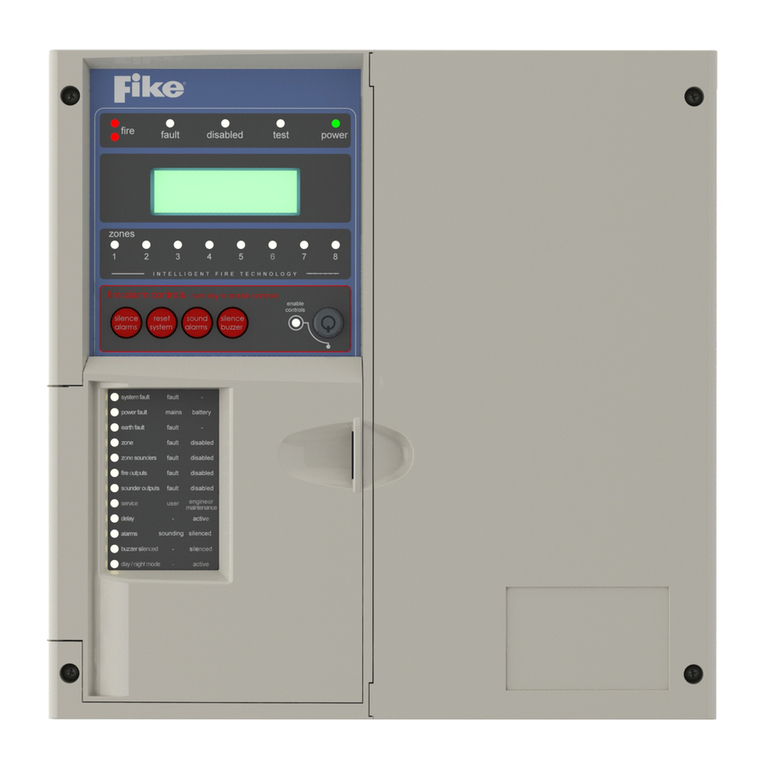
Fike
Fike Twinflex pro2 User manual

Fike
Fike GB2426367 User manual

Fike
Fike FCP-75 User manual
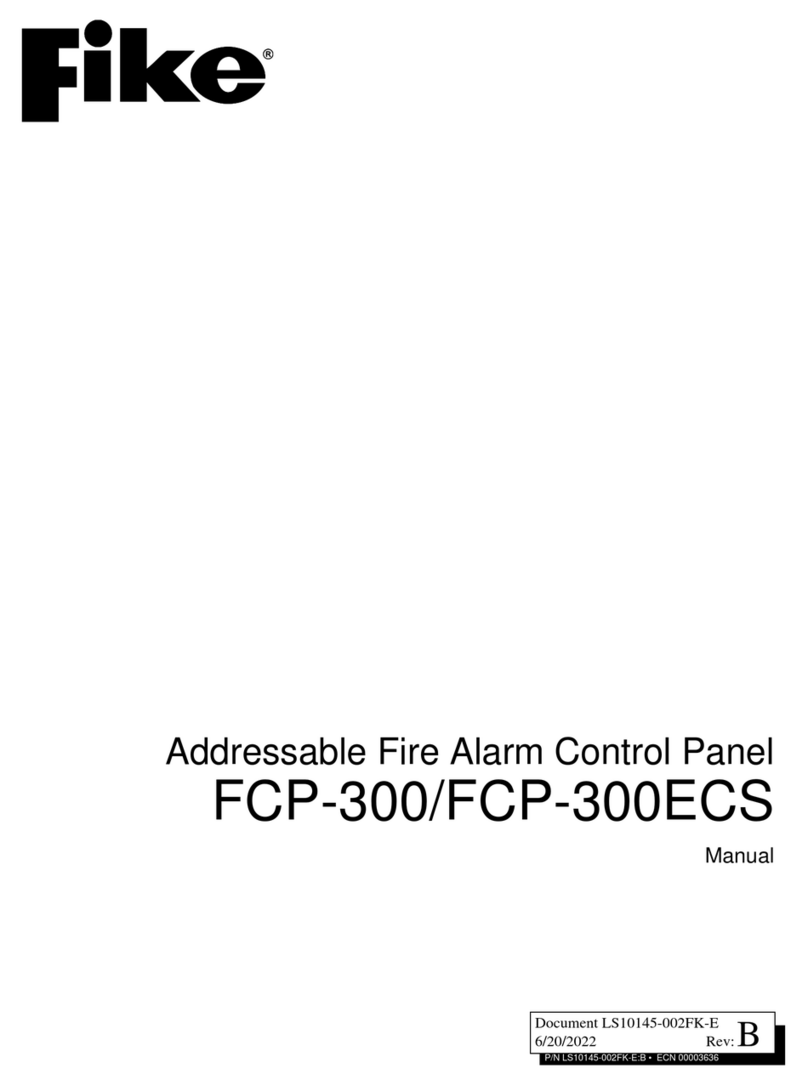
Fike
Fike FCP-300 User manual
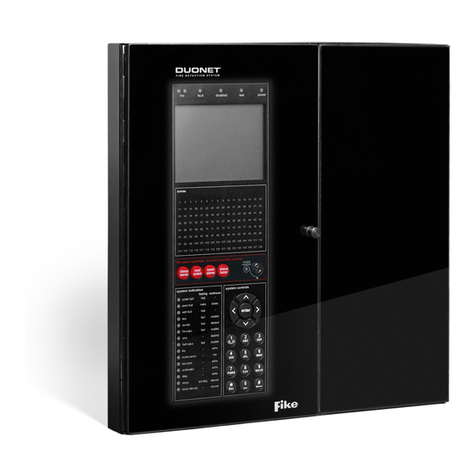
Fike
Fike Quadnet User manual
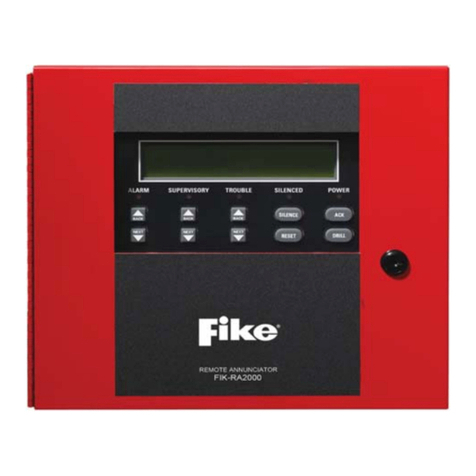
Fike
Fike FIK-RA2000 Technical manual
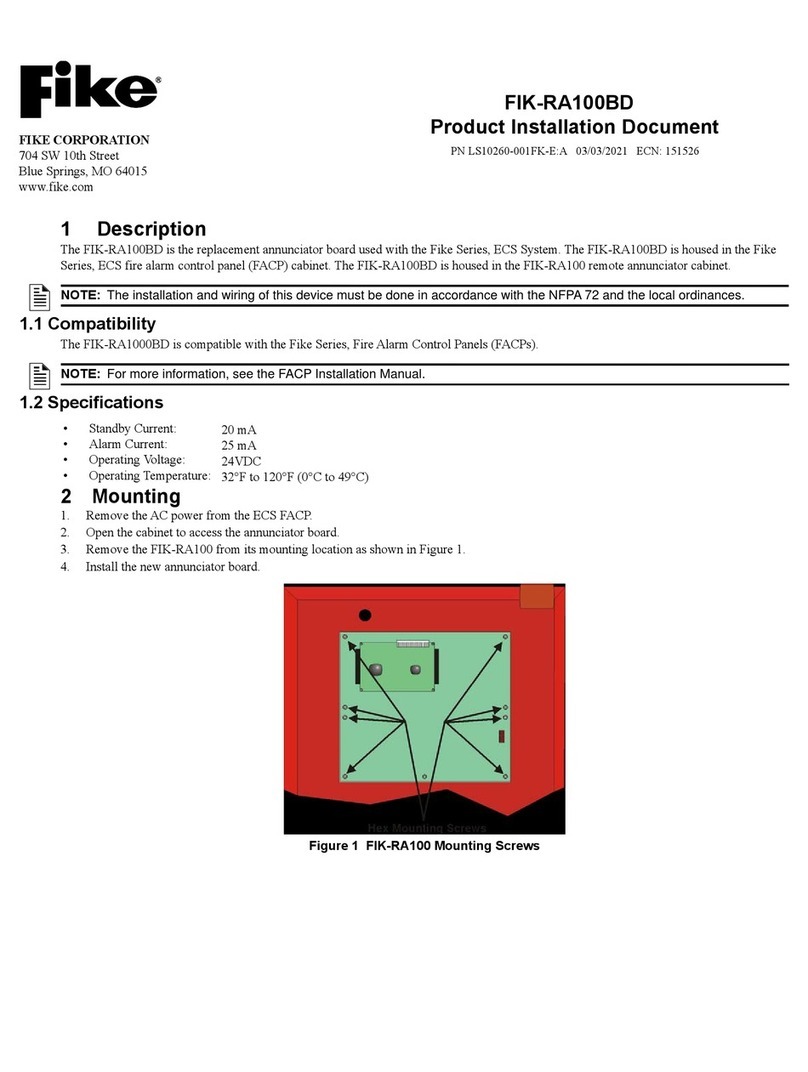
Fike
Fike FIK-RA100BD Technical manual
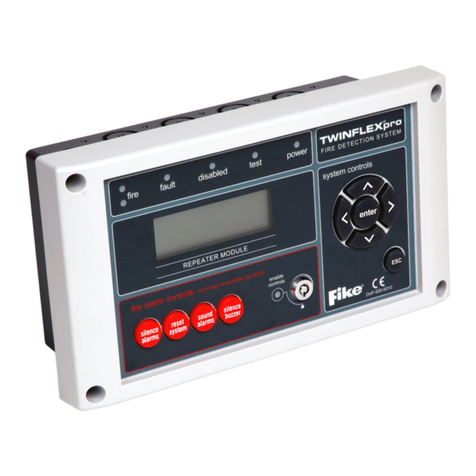
Fike
Fike TWINFLEXpro User manual
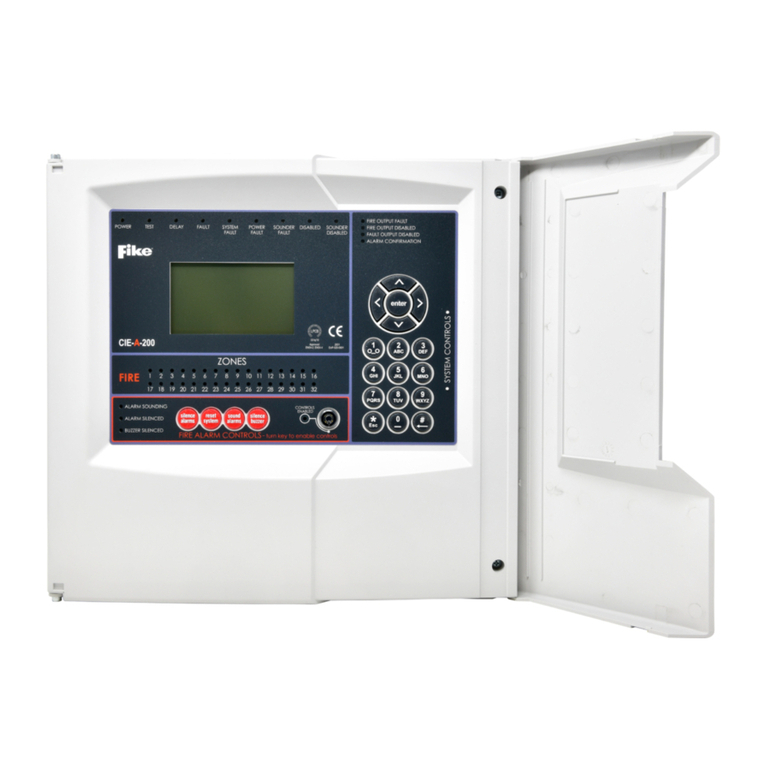
Fike
Fike CIE-A-200 User manual

Fike
Fike SITA200plus User manual


